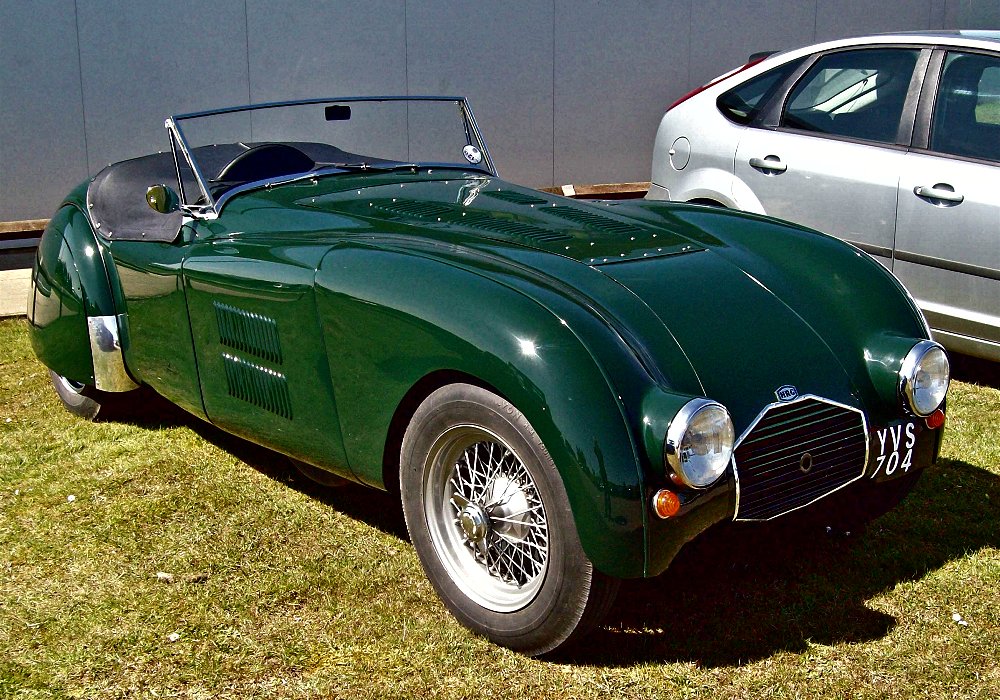Description
The HRG 1500 Aerodynamic was one of the rarest and most striking variants of the HRG 1500 series, built in extremely limited numbers during the late 1940s. It represented the company’s most ambitious attempt to combine its traditional lightweight engineering with a modern, streamlined body—an effort to improve performance through aerodynamics rather than additional power. The result was one of the most distinctive small-displacement British sports cars of its era, a machine that captured both the spirit of postwar innovation and HRG’s enduring commitment to craftsmanship and driver engagement.
The Aerodynamic model was based mechanically on the standard HRG 1500, which itself was renowned for its agility, reliability, and simplicity. Beneath its sculpted coachwork lay the same sturdy tubular steel chassis used in other HRG models, featuring independent front suspension with a transverse leaf spring and a live rear axle with semi-elliptic leaf springs. This configuration provided predictable handling and a balance between comfort and responsiveness that had earned HRG cars their loyal following.
Power came from the same 1,497 cc overhead-camshaft four-cylinder engine sourced from Singer, extensively tuned by HRG engineers to deliver between 60 and 75 horsepower depending on specification. The engine was paired with a close-ratio four-speed gearbox and drove the rear wheels. While the output figures might seem modest, the car’s low weight—barely 700 kilograms—and sleek aerodynamic design gave it exceptional performance for its displacement. With the new streamlined body, the Aerodynamic could exceed 100 mph (160 km/h), a remarkable figure for a 1.5-litre car in the late 1940s.
What truly set the HRG 1500 Aerodynamic apart was its body design. Created in collaboration with the renowned coachbuilder Fox & Nicholl and influenced by contemporary aerodynamic studies, the aluminum body featured flowing, teardrop-inspired lines that contrasted sharply with the more traditional open-wheel style of earlier HRGs. The front end was dominated by a low, faired-in nose with integrated headlights, while the fenders blended smoothly into the bodywork rather than standing proud as separate wings. The cockpit was enclosed beneath a low, rounded roofline that tapered elegantly toward the tail, creating a sleek fastback silhouette. Every curve and contour was shaped to reduce drag and improve stability at speed, making the Aerodynamic one of the most advanced British sports cars of its day in terms of design philosophy.
Inside, the car retained HRG’s characteristic simplicity and driver focus. The two-seat cockpit was compact and functional, with thinly padded seats, a large steering wheel, and a minimal dashboard carrying only the essential instruments. The materials were plain but of high quality, and the craftsmanship reflected the hand-built nature of every HRG. Despite the closed body, the car remained light and unpretentious—a pure driver’s machine designed around performance and precision rather than comfort.
On the road and track, the 1500 Aerodynamic was impressive. The streamlined body reduced wind resistance significantly, improving both top speed and fuel efficiency. The low drag also enhanced stability at high speeds, a benefit particularly valuable in endurance racing. The combination of responsive steering, balanced suspension, and light weight gave the car superb handling, allowing it to maintain high cornering speeds with confidence and precision.
The HRG 1500 Aerodynamic achieved its greatest fame in competition, where it demonstrated both speed and reliability. One of the factory-entered cars, driven by Eric Thompson and Jack Scott, competed in the 1949 24 Hours of Le Mans and achieved an outstanding result—eighth overall and first in its class. This performance against larger and more powerful machinery cemented HRG’s reputation as a serious racing manufacturer despite its small scale. The Le Mans result remains one of the company’s greatest achievements and a testament to the effectiveness of the Aerodynamic’s design.
Production numbers were extremely limited—fewer than a dozen HRG 1500 Aerodynamic cars are believed to have been built, and only a handful survive today. Each was hand-assembled at HRG’s Tolworth workshop, often with slight variations depending on customer specification. The small output was due not only to the company’s modest size but also to the specialized nature of the bodywork, which required skilled craftsmanship and added considerable cost compared to the open 1500 models.
Today, the HRG 1500 Aerodynamic is one of the most desirable and historically significant British sports cars of the immediate postwar era. It represents the high point of HRG’s engineering ambition—a car that combined the company’s traditional mechanical purity with cutting-edge aerodynamics and racing success. Its rarity, competition pedigree, and timeless beauty make it highly sought after by collectors and enthusiasts of pre- and postwar sports cars.
The Aerodynamic stands as a perfect example of HRG’s philosophy: performance achieved through lightness, precision, and thoughtful design rather than brute force. Elegant, efficient, and technically fascinating, the HRG 1500 Aerodynamic remains one of the most distinctive small-capacity sports cars ever built—a remarkable achievement for a tiny manufacturer that earned its place in British motoring history through ingenuity and craftsmanship rather than scale.
